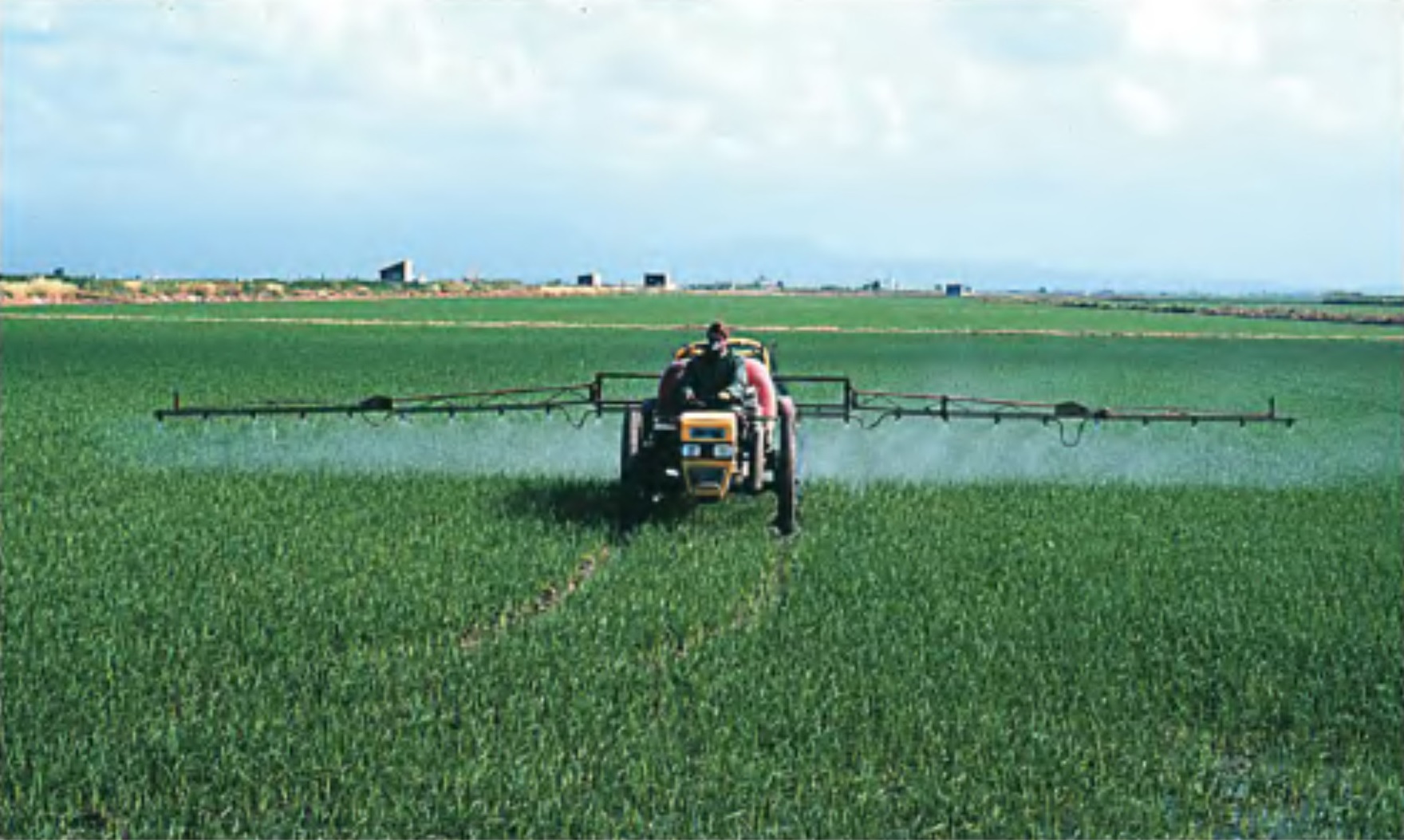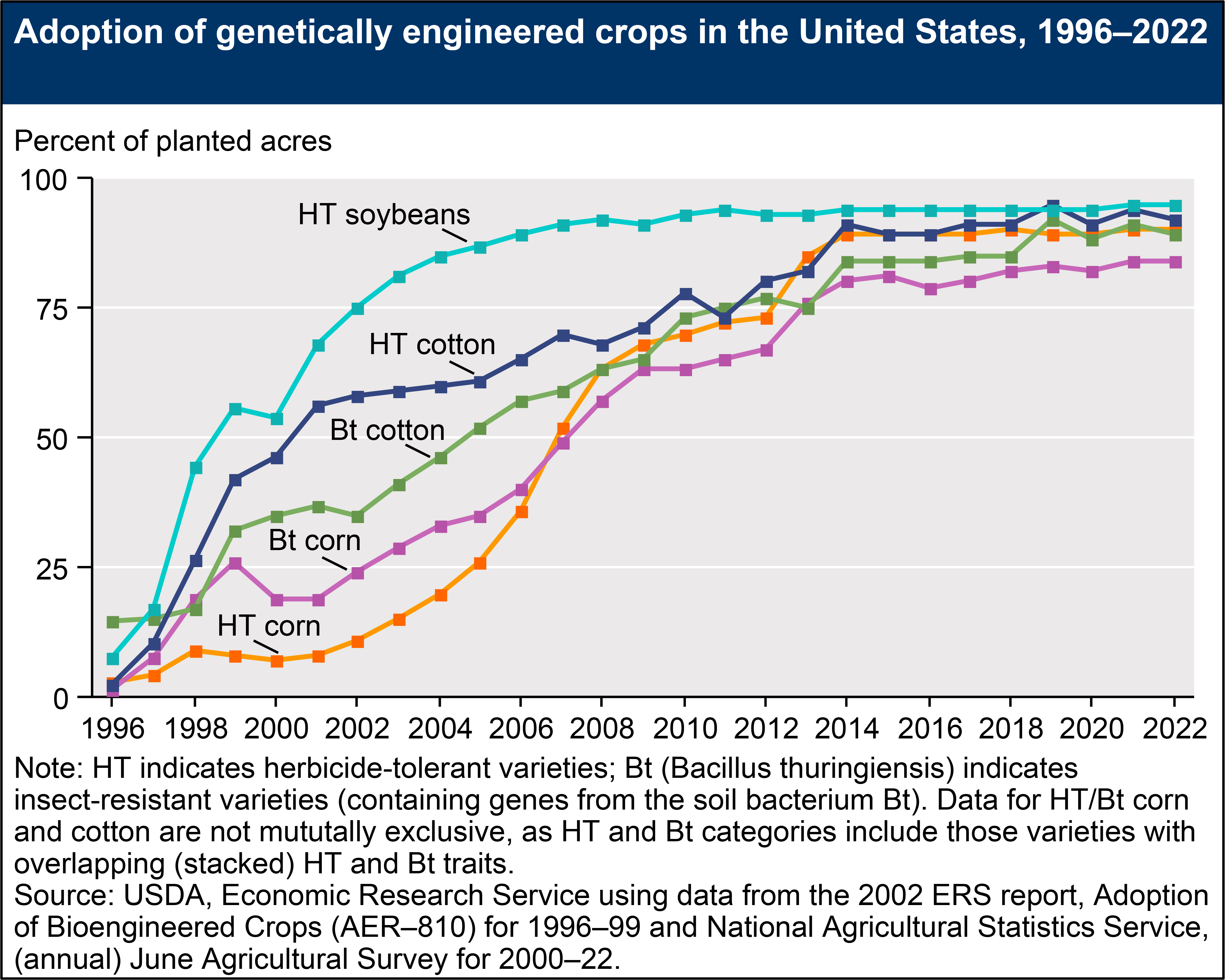Herbicides, also commonly known as weed killers, are substances used to control undesired plants (weeds). Some herbicides, such as dicamba, work as plant growth regulators, causing abnormal cell division, which causes the weeds to die. In 1996, manufacturers introduced seeds that were genetically engineered to be resistant to dicamba. Dicamba does not damage crops grown from these seeds but kills weeds growing near the crops. This is enormously beneficial for farmers, increasing their crop yields and efficiency.
 However, there are several problematic issues associated with these seeds: 1) Dicamba can “drift” from the fields where it is sprayed and damage crops in neighboring fields that are not grown from dicamba-tolerant seeds, 2) Weeds become naturally resistant to the herbicide, and over time, the herbicide is no longer effective.
However, there are several problematic issues associated with these seeds: 1) Dicamba can “drift” from the fields where it is sprayed and damage crops in neighboring fields that are not grown from dicamba-tolerant seeds, 2) Weeds become naturally resistant to the herbicide, and over time, the herbicide is no longer effective.
Genetically engineered seeds
The adaption of genetically engineered seeds has been rapid across the US; today, over 90% of soybeans, cotton, and corn crops are the product of genetically engineered seeds. Genetically engineered dicamba-tolerant seeds were introduced in the US in 1996 and are used primarily for soybeans, cotton, and corn. The States with the most dicamba-tolerant seed use in 2018 were Mississippi, Tennessee, and Kansas, with approximately 79%, 71%, and 69% of soybean acreage, respectively, planted with dicamba-tolerant seeds.  Without dicamba-tolerant seeds, severe weed infestations can cause more than a 50% reduction in soybean yields.
Without dicamba-tolerant seeds, severe weed infestations can cause more than a 50% reduction in soybean yields.
Regulation of Dicamba
The EPA is charged with approving pesticide and herbicide use in the US. The applicant must show that using the product “will not generally cause unreasonable adverse effects on the environment.” [1]
The EPA first approved using Dicamba for crops, lawns, golf courses, and gardens. Before 2016, dicamba use was restricted to mixing it in the soil before planting a crop and application at a specified time (approximately 10 to 30 days) before a crop was harvested. This changed in 2016 and 2017 when the EPA approved spraying dicamba on the growing plant - “over-the-top, or post-emergent use” for dicamba-tolerant soybean and cotton. This change was approved because spraying dicamba on the growing plant is the most effective method for killing weeds when dicamba-tolerant crops are planted. In 2018, the EPA extended that approval for an additional two years, with some changes to the registrations and labeling.
The Challenge of Volatility
When dicamba is applied to the growing dicamba-tolerant plants, some of it volatilizes and can float thousands of feet downwind, damaging and killing crops in neighboring fields that are not dicamba-tolerant. Non-dicamba-tolerant soybeans are particularly susceptible to the toxic effects of dicamba and can be killed even when low doses are sprayed.
Manufacturers have responded by producing lower volatility dicamba products designed to limit the amount of off-site movement. The EPA has responded with controls such as
- requiring a volatility reduction agent to be mixed with the herbicide
- a downwind buffer of approximately 300 feet in areas where other crops are grown
- cut-off dates in the summer for applying the herbicide (there is more drift at higher temperatures)
However, problems remain. The EPA has tracked reported incidents involving crop damage from the off-site movement of dicamba. In 2021 there were 3,500 dicamba-related incidents, with little change in the number, severity, or geographic extent from 2020, when control measures were implemented.
Some states are acting on their own and requiring additional restrictions on dicamba. For example, Minnesota does not allow the application of dicamba after June 12 – 31 (depending on the part of the state). It prohibits application if the temperature is over 85 degrees or if the National Weather Service forecasted high temperature for the day exceeds 85 degrees.
Of course, there are lawsuits.
The EPA’s 2018 decision to extend approval for three dicamba-based herbicides was very controversial. The EPA’s Office of Inspector General concluded that this decision varied from typical operating procedures because EPA did not conduct the required internal peer reviews of scientific documents created to support the dicamba decision, leaving the EPA vulnerable to legal action.
Several environmental groups filed suit to review the 2018 dicamba extensions. In June 2020, the Ninth Circuit US Court of Appeals vacated (overruled) EPA’s 2018 dicamba registrations because it violated the Federal Insecticide, Fungicide, and Rodenticide Act (FIFRA) by substantially understating risks that it acknowledged and failing entirely to acknowledge other risks. The EPA issued cancellation orders for the existing stock of the affected herbicides.
In October 2020, the EPA approved new five-year registrations for two of the three dicamba-based herbicides canceled in the 2020 court decision and one additional dicamba-based herbicide. Responding to the court’s decision, the EPA included new control measures to “ensure these products can be used effectively while protecting the environment, including non-target plants, animals, and other crops not tolerant to dicamba.”
In April, several environmental groups asked the court to rescind the approval of the dicamba-based herbicides again, saying that “In re-approving dicamba, the EPA failed once again to weigh the true costs to farmers and the environment.”
“Weeds are the number one pest in agriculture and the number one input that we spend money on, other than fertilizer.”
Weed control has plagued farmers for generations. In 1918, a government publication said, “No other single feature of farming requires such universal and increasing attention.” Modern-day farming still faces many challenges, as demonstrated by dicamba. Herbicide-tolerant seeds have been a huge breakthrough for many farmers, significantly increasing per-acre yield and efficiency, but are problematic for those who farm organically, putting their crops at risk.
The challenge for science is to create a solution that does not damage crops in neighboring fields and a means of controlling the increasing resistance to herbicides. These problems require Solomon-like wisdom to solve but are needed to increase food production in an increasingly hungry world.
[1] Defined as: 1) Any unreasonable risk to man or the environment, taking into account the economic, social, and environmental costs and benefits of the use of any pesticide; 2) A human dietary risk from residues that result from a use of a pesticide in or on any food inconsistent with the Federal Food, Drug, and Cosmetic Act.
Crop spraying image courtesy of Miquel Pujo




